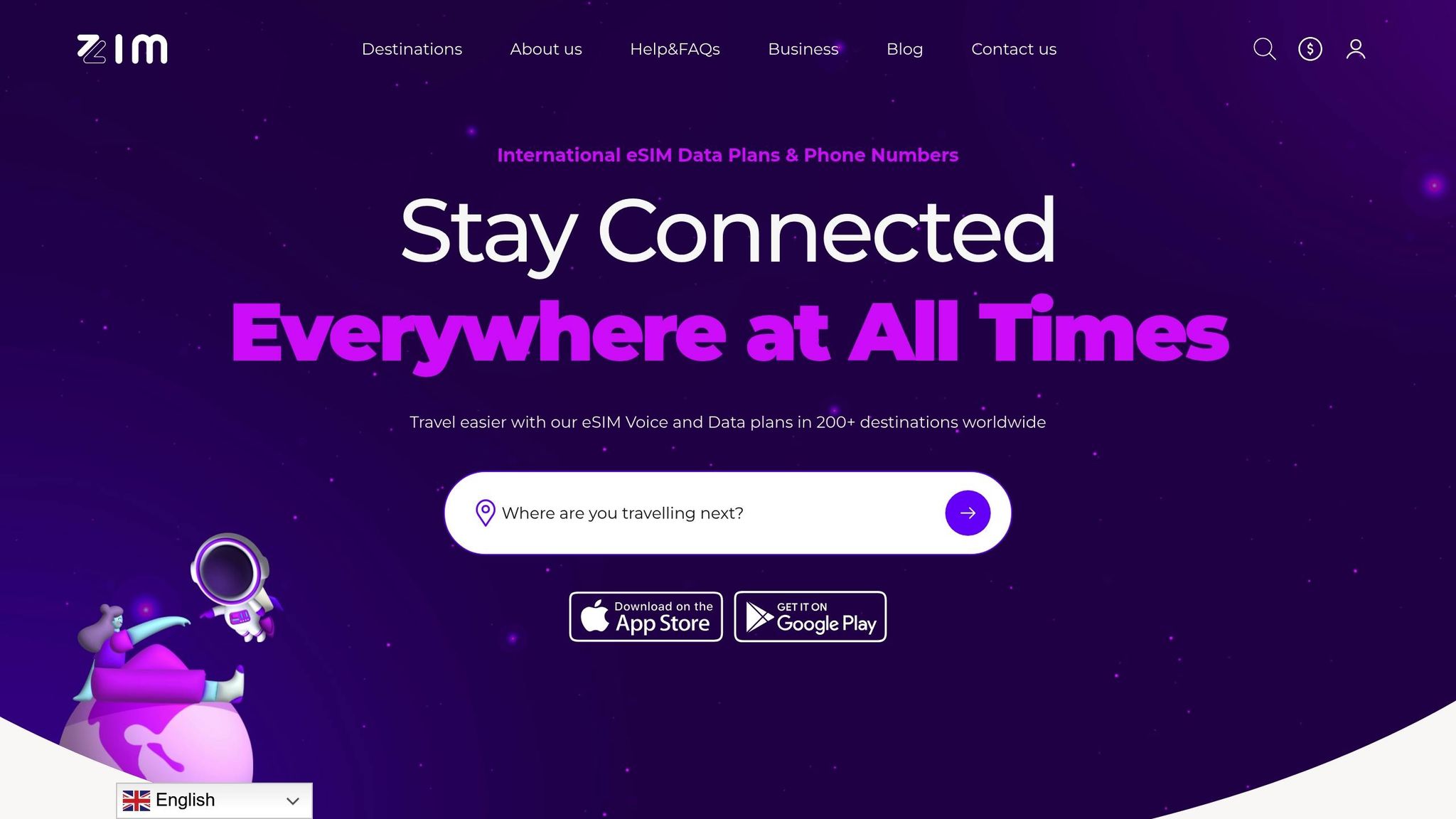Cross-Border Data Transfers: Regional Plan Tips
https://www.zimconnections.com/cross-border-data-transfers-regional-plan-tips/
 SHARE
SHARE
Cross-border data transfers are essential for businesses operating internationally but come with complex regulations that vary by region. From GDPR in Europe to Brazil’s LGPD and California’s CPRA, businesses must comply with local data protection laws to avoid fines, maintain customer trust, and ensure smooth operations.
For organisations using eSIM technology, regional plans tailored to specific regulatory frameworks can simplify compliance. Unlike traditional SIM cards, eSIMs allow for digital network switching, offering greater control over data routing and storage. Providers like ZIM Connections offer solutions designed to meet regional requirements, reducing risks while maintaining reliable connectivity.
Key steps for compliance include:
- Mapping data flows to identify risks.
- Using legal mechanisms like Standard Contractual Clauses (SCCs) or data localisation.
- Prioritising features like encryption, audit trails, and local support in eSIM plans.
- Regularly auditing and updating documentation to ensure adherence to laws.
With a clear strategy and the right tools, businesses can navigate the challenges of cross-border data transfers efficiently.
Key Data Transfer Regulations for Regional eSIM Plans
Major Regulatory Frameworks
The General Data Protection Regulation (GDPR) sets the benchmark for data protection across the European Union and the UK. Network providers must adhere to GDPR protocols when transferring data, especially when routing it outside the EU or UK. This regulation mandates explicit consent for such transfers unless specific safeguards are in place.
Similarly, the UK GDPR, which operates independently after Brexit, mirrors the EU framework. British businesses using eSIMs must navigate both regulations when engaging in cross-border operations. The Information Commissioner’s Office (ICO) has emphasised that data transfers to countries without “adequacy” status require additional protections. This directly impacts how regional eSIM plans manage traffic routing.
Both GDPR and UK GDPR demand that cross-border data transfers include appropriate safeguards to ensure compliance.
In Latin America, Brazil’s Lei Geral de Proteção de Dados (LGPD), in effect since September 2020, imposes GDPR-like restrictions. Non-compliance can lead to fines of up to 2% of revenue or R$50 million per violation. For businesses using eSIMs in the region, understanding LGPD is critical as data may pass through Brazilian networks.
The California Consumer Privacy Act (CCPA) and its successor, the California Privacy Rights Act (CPRA), regulate any business handling data from California residents. With fines reaching $7,500 per violation, businesses must be vigilant when eSIM traffic routes through the United States, even briefly.
In Southeast Asia, Singapore’s Personal Data Protection Act (PDPA) governs cross-border data transfers. The Act requires organisations to ensure adequate protection for data sent overseas, making it a key consideration for eSIM plans covering Asia-Pacific routes.
These varied frameworks demand tailored legal approaches to ensure data transfer compliance.
Legal Methods for Compliant Data Transfers
To navigate these regulations, businesses can rely on several legal mechanisms for compliant data transfers:
- Standard Contractual Clauses (SCCs) are a widely used method for cross-border data transfers. Updated by the European Commission in June 2021, SCCs require businesses to evaluate whether the destination country’s laws might undermine the protections provided. eSIM providers must secure valid SCCs from their network partners to remain compliant.
- Binding Corporate Rules (BCRs) are another option, particularly for multinational corporations. These rules allow data transfers within the same corporate group across various countries. However, since BCRs require approval from data protection authorities, they may not be suitable for businesses needing quick eSIM deployment.
- Adequacy decisions simplify compliance by recognising certain countries, such as Canada, Japan, and South Korea, as having sufficient data protection standards. eSIM plans that route data exclusively through these countries face fewer regulatory challenges.
- Data localisation laws in countries like Russia and China require data to be stored within their borders. This directly impacts eSIM plan configurations, as providers must balance compliance with local storage rules while maintaining connectivity.
- Explicit consent is another option but is often impractical for automated data flows in business operations.
How Regulations Affect eSIM Plan Management
Managing eSIM plans under these regulations requires a blend of legal and technical strategies.
Network routing must prioritise regulatory compliance over technical efficiency. For instance, European eSIM plans might avoid routing data through the US to maintain GDPR compliance.
Data residency requirements also play a significant role. Providers must determine where to store user profiles and connection logs. For example, while Australia has no specific data residency laws, Indonesia mandates certain data to remain within its borders, complicating plans targeting the Asia-Pacific region.
Audit trails and documentation are indispensable for regulatory compliance. eSIM providers must maintain detailed records of data transfers, including which networks handle the data and where it is processed. This documentation is crucial during investigations or audits.
Real-time compliance monitoring has become essential for modern eSIM management. Platforms must continuously track data flows and alert administrators if transfers risk breaching local regulations. These measures ensure connectivity remains seamless while adhering to legal requirements.
The challenges of managing these diverse requirements across multiple jurisdictions have led many businesses to partner with eSIM providers experienced in regional compliance. For instance, ZIM Connections designs its regional plans with these regulations in mind, grouping countries with similar data protection standards. This approach simplifies compliance while maintaining strong connectivity across regions.
How to Customise Regional eSIM Plans for Compliance
Assess Regions and Applicable Regulations
To ensure your eSIM plans comply with regulations, start by identifying all the regions where your organisation operates. Each country may have its own data protection rules, so understanding these is crucial. Create a regulatory map that categorises countries based on their data protection laws. This map will help you group regions with similar frameworks, making it easier to address compliance needs.
By assessing these regulations, you’ll gain a clearer picture of how data flows should be managed and where potential vulnerabilities might arise.
Map Data Flows and Identify Risks
Mapping your data flows is a critical step in meeting compliance standards. Document every stage of the data journey – from device authentication to its final destination. Collaborate with your eSIM provider to understand their network structure and routing policies, ensuring you know when and where data might cross international borders.
Once your data flow map is complete, compare it to the regulatory requirements for each region. This will help you spot any potential compliance gaps. Use a risk assessment matrix to evaluate the likelihood and impact of these issues. Don’t forget to document your data retention and storage practices to ensure they align with local standards. This process lays the groundwork for customising your eSIM plans.
Tailor eSIM Plans for Compliance
With a clear understanding of regulations and risks, you can now adjust your eSIM plans to meet both compliance and operational needs. For example, request region-specific routing to ensure data stays within approved jurisdictions. You can also use geographically distributed eSIM profiles to keep connectivity local, avoiding unnecessary cross-border data transfers.
Automated controls are another powerful tool. These can be embedded into your eSIM management platform to minimise the risk of accidental breaches. Implement strategies to limit the collection and transfer of personal data, ensuring you only handle what’s absolutely necessary for connectivity.
Formalise your arrangements by establishing data processing agreements with your eSIM provider. These agreements should clearly outline compliance responsibilities and data protection measures. Regular audits and monitoring are essential to test your configuration, and alerts can help you quickly detect and address any unauthorised data flows.
ZIM Connections offers solutions tailored for compliance, allowing businesses to configure regional eSIM plans that align with compatible data protection frameworks. Their platform supports routing preferences and automated controls, helping you maintain regulatory compliance while ensuring reliable connectivity across multiple countries.
Navigating the Dynamic Cross Border Data Privacy Landscape
sbb-itb-273ea09
Best Practices for Secure Cross-Border Data Transfers
Here’s how organisations can ensure secure cross-border data transfers while staying compliant with regional eSIM regulations.
Audit Data Flows and Keep Documentation Updated
Regular audits are a cornerstone of cross-border data compliance. Organisations should review their data flows at least once a year or after significant operational changes. This involves mapping out every point where data is transferred, documenting the legal basis for each transfer, and verifying compliance with regulations like GDPR, CCPA, and the DOJ Rule.
For instance, a U.S. company adopted quarterly audits using a metadata management platform, cutting compliance incidents by 30% and improving audit results.
The DOJ Rule, effective from 8 April 2025, has added a layer of complexity to cross-border data transfers, shifting the focus from privacy to national security. It imposes restrictions and bans on transactions involving certain nations, including China, Russia, and Iran. This change impacts various areas, such as mergers, employment agreements, data licensing, and supplier management, affecting thousands of U.S. companies.
Once audits and documentation are up to date, organisations can strengthen their oversight with metadata-driven systems.
Leverage Metadata-Driven Controls
Metadata-driven controls simplify the management of permissions and tracking data lineage across different jurisdictions. By tagging datasets with metadata – such as their origin, sensitivity, access permissions, and transfer history – organisations can automate policy enforcement and quickly identify non-compliant transfers.
For example, metadata can restrict data access based on a user’s location or role. These controls also generate detailed audit trails, which are crucial during regulatory inspections. Automated systems not only enforce compliance but also streamline reporting, making it easier to demonstrate adherence to regulations.
These systems work hand in hand with staff training to bolster data security.
Train Staff and Implement Automation Tools
Well-trained staff are essential for preventing data breaches. Employees should understand data protection laws, secure transfer protocols, breach reporting procedures, and documentation requirements. Equally, they need to be familiar with automation tools and metadata-driven systems that enhance compliance efforts.
For example, a global financial services firm introduced automated compliance monitoring tools in early 2025. This move reduced manual compliance tasks by 40% and helped the company avoid a potential £2 million GDPR fine during a regulatory inspection.
Choose the Right Regional eSIM Plan for Your Needs
When selecting a regional eSIM plan, it’s essential to align it with your business needs while ensuring compliance with regulatory standards. Plans that include automated compliance monitoring not only help you stay within legal boundaries but also keep costs under control. Here’s a breakdown of the key compliance features you should prioritise when tailoring a regional eSIM plan.
Key Compliance Features to Consider
To tackle regulatory challenges effectively, focus on features that address specific compliance requirements. For instance, data localisation is a crucial feature, as it ensures personal data is stored and processed within the appropriate jurisdictions. This adds an extra layer of security and keeps you aligned with local regulations.
Another must-have is end-to-end encryption, such as AES-256. This is especially vital when transferring sensitive data across borders, as encryption provides an additional safeguard under laws like GDPR or CCPA.
Look for plans that include detailed audit trails. These should document timestamps, locations, and access logs, making it easier to handle regulatory inspections and meet documentation requirements.
Additionally, ensure the plan offers local customer support in your operating regions. Teams familiar with regional regulations can significantly speed up response times for compliance-related issues, such as data breach notifications or regulatory inquiries.
Finally, check whether the plan is compatible with all the devices your organisation uses, from smartphones and tablets to IoT devices and mobile hotspots. Compatibility ensures seamless connectivity across your operations.
Use a Comparison Table to Evaluate Plans
A comparison table can help you evaluate and identify the best plan for your needs. Focus on features that impact both compliance and operational efficiency.
| Plan Feature | Local Plans | Regional Plans | Global Plans | Priority Level |
|---|---|---|---|---|
| Data Localisation | Single country only | Multi-country within region | Limited regional control | High |
| Compliance Support | Country-specific | Regional framework alignment | Basic global standards | High |
| Coverage Flexibility | Restricted | Moderate | Extensive | Medium |
| Cost Efficiency | Low data volumes | Balanced for regional use | Higher for extensive travel | High |
| Support Availability | Local hours | Regional coverage | 24/7 global | Medium |
When creating your comparison, include details such as plan type, covered regions, compliance features, and implementation notes. This approach makes it easier to spot gaps between your requirements and the available options.
ZIM Connections is a notable provider offering local, regional, and global plans across over 200 destinations. Their regional plans simplify connectivity across multiple countries, reducing the hassle of managing separate eSIMs while adhering to local data transfer regulations.
For organisations handling large volumes of cross-border data transfers, prioritise plans with unlimited data options. This reduces the risk of disruptions during critical tasks like audit reporting or emergency data breach notifications.
Lastly, consider the ease of activation. For companies with distributed teams, plans with simple digital activation processes can significantly reduce administrative overheads. This ensures a smooth and consistent rollout across different regions, all while maintaining compliance with diverse regulatory requirements.
Building a Cross-Border Data Strategy
After diving into regulatory frameworks and customisation tactics, the logical next step is crafting a cross-border data strategy. This strategy should find the right balance between staying compliant with regulations and maintaining smooth, efficient operations across different regions.
Essentials for Cross-Border Data Compliance
To stay ahead of regulatory shifts, it’s crucial to embed compliance into your operations from the very beginning. Start by developing clear data governance policies that align with the diverse requirements of each region you operate in. Pair these policies with timely technical measures to safeguard your data.
Regular training sessions and meticulous record-keeping can go a long way in reducing the risk of compliance failures. Conducting advanced cross-border compliance drills ensures your team is well-versed in both the technical and legal nuances of handling data across borders.
Technology plays a pivotal role here too. Opt for connectivity solutions that offer automated compliance monitoring, helping you stay on top of regulations while simplifying your processes.
These foundational steps set the stage for leveraging effective connectivity solutions.
How ZIM Connections Can Enhance Your Strategy

Once your compliance framework is in place, the right connectivity solution can further streamline your cross-border data strategy. ZIM Connections provides the infrastructure you need for compliant and efficient operations across jurisdictions. Their regional eSIM plans are especially beneficial for organisations working in multiple countries within a region, as they simplify connectivity management while ensuring adherence to local data transfer laws.
With a range of local, regional, and global plans, you can customise your connectivity approach to suit both your compliance needs and operational goals. This aligns perfectly with the eSIM management practices discussed earlier.
Digital activation makes deployment quick and hassle-free, which is particularly valuable for distributed teams. This ease of use helps eliminate connectivity gaps, ensuring uninterrupted oversight.
Moreover, features like 5G/4G internet connectivity and unlimited data options support seamless data transfer and continuous monitoring. This allows you to respond swiftly to any compliance challenges that may arise, keeping your operations running smoothly.
FAQs
How can regional eSIM plans help businesses meet international data protection requirements?
Regional eSIM plans are tailored to help businesses navigate the complexities of international data protection laws, like GDPR in Europe. They align connectivity solutions with the specific regulations of each region, often incorporating advanced security measures to ensure sensitive data is managed according to local privacy standards.
These plans also make it easier for businesses to address data localisation and sovereignty requirements, which are essential when operating across borders. This approach not only minimises legal risks but also ensures uninterrupted connectivity while staying compliant with regional regulations.
What should I consider when managing data flows to comply with cross-border data transfer regulations?
To comply with cross-border data transfer regulations, it’s important to familiarise yourself with the legal requirements specific to each region, like the GDPR in the EU or China’s data protection laws. A good starting point is to create a detailed data map. This will allow you to track where data is being transferred, processed, and stored, helping you pinpoint potential risks and maintain transparency.
Carrying out regular audits and conducting data transfer impact assessments (TIAs) is another crucial step. These practices can uncover compliance gaps and ensure your data transfers adhere to legally approved frameworks, such as standard contractual clauses or binding corporate rules. By staying ahead of regulatory changes and keeping your processes in check, you can balance compliance with your business priorities effectively.
Why should businesses regularly review and update their cross-border data transfer documentation?
Keeping documentation up-to-date for cross-border data transfers is a must for navigating evolving regulations and tackling emerging security issues. It ensures your organisation’s data practices align with legal standards while reducing the risk of fines or reputational harm.
Regular audits of this documentation can highlight compliance gaps, ensure processes reflect the latest regulations, and enhance your data protection measures. Taking these proactive steps not only reduces risks but also reinforces trust with clients and partners by showing a strong commitment to protecting sensitive information.









































































































































































































